Understanding the Basics of Solar Energy Systems
Solar energy systems are a clean, renewable power source. They harness sunlight, allowing it to fuel residential and commercial properties with electricity. The core component of these systems are solar panels, comprised of small cells generally made from silicon, which capture sunlight and convert it into direct current (DC) electricity. This DC electricity is then converted into alternating current (AC) electricity by an inverter. AC electricity is the type of power that is used by most household appliances.
Crucially, solar energy systems are also armed with a metering system that measures the output of electricity. Sophisticated models even allow for excess energy production to be sent back to the grid, causing your meter to “spin backwards”, thus credits your account. Meanwhile, during times when the solar system doesn’t produce enough energy like cloudy or nighttime periods, energy is drawn from the grid. This results in a balanced, sustainable energy approach that can lead to both environmental and financial benefits.
Understanding the basics of solar energy systems involves learning about their fundamental components and how they operate. These include:
- Solar Panels: Considered as the heart of a solar energy system, these panels are made up of small cells, typically composed of silicon. They capture sunlight and convert it into DC electricity.
- Inverter: The direct current (DC) electricity generated by the solar panels is converted into alternating current (AC) electricity by an inverter. AC power is compatible with most household appliances.
- Metering System: This component measures the amount of electricity produced by your solar energy system. It helps keep track of your overall power consumption and production levels.
Solar energy systems also have unique features that make them beneficial for both users and the environment:
- Grid-Tied Systems: More advanced solar setups allow excess power to be fed back into the grid when not needed at home or business premises. This results in “net metering,” where you receive credits on your account for contributing to shared power resources.
- Energy Security During Off-Peak Hours: Even during periods when there’s insufficient sunlight such as cloudy days or nighttime, you can still draw power from the grid ensuring consistent access to electrical supply.
Embracing a sustainable approach like using a solar energy system offers several advantages:
- Environmental Benefits: As a renewable source, harnessing sun’s energy reduces our reliance on fossil fuels thereby decreasing greenhouse gas emissions contributing towards climate change mitigation efforts.
- Financial Savings : By producing part or all your own electricity needs through this method could significantly lower utility bills over time while enabling potential earnings via net-metering schemes if applicable in your locality.
In conclusion, understanding how different components work together within a solar energy system allows us to appreciate its efficiency and sustainability benefits more fully – paving way for wider adoption across residential and commercial sectors globally
Choosing Between Self-Installation and Hiring a Professional
 As one embarks on the journey to harness solar power, a crucial decision confronts every potential solar energy adopter: the option of self-installation or employing the services of a professional. This choice, much like every other, is susceptible to individual circumstances, preferences and abilities. Both avenues have their unique advantages and disadvantages, necessitating informed decision-making.
As one embarks on the journey to harness solar power, a crucial decision confronts every potential solar energy adopter: the option of self-installation or employing the services of a professional. This choice, much like every other, is susceptible to individual circumstances, preferences and abilities. Both avenues have their unique advantages and disadvantages, necessitating informed decision-making.
The allure of taking the do-it-yourself route might stem from cost-saving intentions or even the fulfilling sensation derived from completing a hands-on project. Conversely, the decision to hire a professional installer often boils down to ensuring professionalism, expertise, and a sense of peace knowing that the energy system’s setup is conducted according to industry standards. In this section, we’ll carry out an in-depth examination of these two alternatives, laying out the key considerations that will help in making this vitally important choice.
- Self-Installation: The do-it-yourself approach to solar panel installation can present a number of benefits, particularly for those who are handy and enjoy taking on home projects.
◦ Cost Savings: One of the most prominent advantages is the potential cost savings. By handling the project yourself, you eliminate labor costs which could amount to a significant portion of your total expenditure.◦ Personal Satisfaction: There’s also an undeniable sense of accomplishment that comes with completing such a task. This satisfaction might be enough motivation for some homeowners.However, it’s important to remember that self-installation isn’t without its challenges:◦ Technical Knowledge Requirement: Installing solar panels involves dealing with electrical systems which requires specific technical knowledge and skills. The lack thereof could lead to improper installation or even accidents.◦ Time Investment: It’s worth noting that this process can be time-consuming especially if you’re new to it. - Hiring A Professional Installer: On the other hand, hiring professional services may come at a higher initial cost but provides several distinct benefits:◦ Expertise and Experience: Professionals have undergone extensive training and have experience in installing various types of solar energy systems. They know how best to optimize system performance based on location and roof orientation among other factors.◦ Safety Assurance: With professionals, there’s less risk involved as they adhere strictly to safety regulations during installations thus preventing any potential accidents or damages.There are however downsides associated with hiring professionals:
◦ Higher Initial Costs: As mentioned earlier, employing professional services will likely increase your initial investment due largely to labor costs.
Ultimately deciding between self-installation and hiring a professional installer depends greatly on individual circumstances including budget constraints, personal preferences as well as comfort level in handling such complex tasks independently vs delegating them safely into expert hands.
Assessing the Pros and Cons of Do-It-Yourself Approach
Deciding to tackle a solar panel installation independently certainly has its merits.
 Foremost among these is the potential for substantial cost savings, as labor constitutes a considerable portion of a solar system installation.
Foremost among these is the potential for substantial cost savings, as labor constitutes a considerable portion of a solar system installation.
Do-It-Yourself (DIY) enthusiasts may also derive satisfaction from the tangible, hands-on involvement in the set-up process, plus it provides an opportune chance to acquire new skills and knowledge.
However, the DIY approach also comes with significant disadvantages, proving this option is not for everyone. Depending on one’s level of understanding and skill, the setup process can be intricate and time-consuming. Mistakes can lead not only to inefficiencies in system performance but also cause potentially serious safety risks. Another considerable disadvantage is the lack of post-installation support and warranty service that is typically provided by professional installers. These are factors that necessitate careful consideration before embarking on a do-it-yourself journey with solar panel installation.
The Pros of DIY Solar Panel Installation:
- Cost Savings: The most apparent advantage of the DIY approach is the potential for significant cost savings. Labor costs account for a substantial portion of solar panel installation charges, and by doing it yourself, you can eliminate these expenses.
- Satisfaction: Completing such a project independently can also provide a great deal of satisfaction. This hands-on engagement not only adds to your sense of accomplishment but also gives you an in-depth understanding and appreciation for how solar power works.
- Skill Acquisition: Undertaking this project allows you to acquire new skills and knowledge about renewable energy sources, electrical systems, and home improvement techniques.
The Cons of DIY Solar Panel Installation:
- Complexity & Time Consumption: Depending on your level of expertise in this area, setting up a solar system can be complex and time-consuming. It requires careful planning, precision during installation, and extensive post-installation testing – all processes that are typically handled by professionals when opting for professional service.
- Potential Risks & Inefficiencies: Mistakes made during the setup process could lead not only to inefficiencies in system performance but pose potentially serious safety risks as well. Electrical work always carries inherent dangers if not done correctly.
- Lack Of Support & Warranty Service: Another major disadvantage is the absence of post-installation support or warranty service which is usually provided by professional installers. If something goes wrong with your system after installation – whether immediately or years down the line – dealing with those issues will be entirely up to you.
Given these pros and cons, it’s clear that while going the DIY route may seem appealing due to its immediate financial benefits; one must consider long-term factors such as ongoing maintenance responsibilities, potential safety hazards associated with incorrect installations, lack thereof warranties before making their decision.
Key Steps in Installing Solar Panels Yourself
Installing solar panels on your property may seem like an intimidating task.
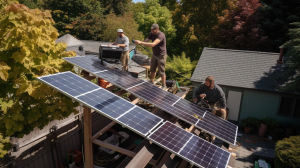 However, with careful planning and attention to detail, the entire process could potentially be a rewarding endeavor that yields significant energy savings. Typically, the process starts with a detailed evaluation of your home’s suitability for solar power, which includes assessing the orientation and tilt of the roof, shading from nearby trees and buildings, and the structural integrity of the roof.
However, with careful planning and attention to detail, the entire process could potentially be a rewarding endeavor that yields significant energy savings. Typically, the process starts with a detailed evaluation of your home’s suitability for solar power, which includes assessing the orientation and tilt of the roof, shading from nearby trees and buildings, and the structural integrity of the roof.
The next crucial step involves carefully measuring and marking the locations on the roof where the solar panels will be installed. For safety and effectiveness, the panels need to be securely mounted on braces that are firmly attached to the roof joists. After the mounting hardware is in place, the panels are lifted onto the roof, attached, and then wired into a solar inverter, which is essentially the brain of the solar energy system. This essential component takes the direct current output from the panels, converts it into alternating current that can be used to power your home, and feeds any excess electricity back into the grid.
- After the initial evaluation of your home’s suitability for solar power, you need to decide on the type and size of the solar panel system that best suits your needs. This decision will depend on factors such as your energy consumption, budget, available roof space and local regulations.
- Once you’ve chosen a suitable system, it’s time to purchase all necessary equipment including solar panels, mounting hardware and an inverter. Make sure to buy from reputable suppliers who offer high-quality products with good warranties.
- The next step involves preparing the installation site. You must ensure that there are no obstructions like chimneys or antennas at the planned location. Also check if any repairs are needed on your roof before starting with the installation process.
- As mentioned earlier, careful measurement is crucial in this stage. Mark out exactly where each panel will go by using chalk lines or laser levels.
- Now comes the physical part – installing brackets or mounts onto your roof joists where each panel will be attached securely. Always follow manufacturer instructions closely when doing this task to avoid any damage or future problems.
- Next up is lifting each panel onto its corresponding mount and securing it firmly into place using bolts provided by manufacturers.
- Once all panels are installed correctly on their respective mounts, they have to be interconnected through wiring which can be quite complex depending upon layout of panels and total number involved in setup.
- Lastly but most importantly is connecting these wired-up panels into a solar inverter which converts direct current (DC) produced by them into alternating current (AC) usable for powering household appliances.
- Finally after successful installation checking performance of entire setup becomes essential so as not only ensuring everything works properly but also optimizing output based upon real-time data collected during first few days/weeks post-installation period.
Remember: Safety should always come first when performing tasks like these yourself; make sure you’re wearing appropriate safety gear and working with someone else whenever possible. If you’re not comfortable or confident in your ability to install the panels yourself, it’s always best to hire a professional installer.
Potential Pitfalls and Challenges in DIY Solar Systems
Installing solar panels, like any meaningful home improvement project, presents various challenges.
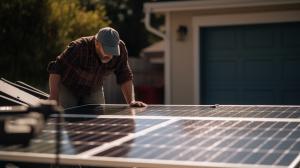 Not all of these issues might be noticeable at first glance, but they can significantly impact the efficiency and performance of the system.
Not all of these issues might be noticeable at first glance, but they can significantly impact the efficiency and performance of the system.
DIY enthusiasts may face difficulties with system design, which includes sizing the system accurately and ensuring adequate electricity production.
It requires an understanding of mathematical principles and an ability to estimate energy needs realistically. Additionally, amateurs often struggle with the proper placement and angling of solar panels, which can lower energy production if not done correctly.
Another challenge that DIY installers often fail to anticipate is compliance with local building codes and regulations. Solar power systems usually need permits and must adhere to specific codes that cover everything from electrical connections to the roof’s structural integrity. Individuals installing the system themselves may lack crucial knowledge in these areas, leading to potential safety hazards or non-compliant setups. Further, deal with potentially dangerous electrical work can be daunting for those without the necessary skills and experience. Therefore, the journey towards harnessing green energy through self-installed solar panels comes with its share of potential pitfalls and challenges.
- The first major challenge is designing the system accurately. This involves:
◦ Sizing the solar panel array correctly to match energy needs.
◦ Ensuring adequate electricity production to meet household demands.
◦ Understanding mathematical principles for accurate calculations. - Proper placement and angling of solar panels can also be a significant hurdle. Improper installation can lead to:
◦ Lower energy production due to inefficient sunlight capture.
◦ Potential damage or wear on panels due to exposure elements. - Compliance with local building codes and regulations is another common pitfall, which includes:
◦ Obtaining necessary permits before starting the installation process.
◦ Adhering strictly to specific codes covering electrical connections, roof integrity, etc. - Lack of knowledge in these areas could result in safety hazards or non-compliant setups such as:
◦ Faulty wiring leading to fire risks or equipment failure,
◦ Structural issues causing potential property damage,
◦ Legal penalties for failing to comply with local regulations. - Dealing with potentially dangerous electrical work is another serious concern. Without proper skills and experience, this task can pose severe threats including:
◦ Risk of electrocution during installation or maintenance,
◦ Incorrectly connected systems that may cause power surges or outages.
In conclusion, while DIY solar installations may seem like an attractive option for green energy enthusiasts, they come with their share of challenges. It’s crucial that individuals are aware of these potential pitfalls before embarking on such projects.
Evaluating the Advantages of Professional Solar System Set-Up
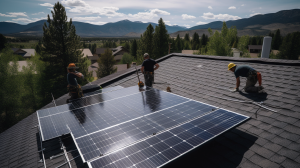 Choosing a professional to install your solar panel system carries substantial benefits.
Choosing a professional to install your solar panel system carries substantial benefits.
For one, professional installers are intensely trained and certified to guarantee a high-quality and safe installation. They provide an in-depth understanding of the numerous types of solar panels, inverters, and other critical system components.
This knowledge increases the overall system reliability and ensures the best possible performance for a more extended period.
Another significant advantage of hiring professionals is their familiarity with the necessary permits and inspections required for proper solar system setup. The procurement of these can be daunting and time-consuming, which an expert installer can conveniently handle. They will also properly assess the roof’s physical parameters, considering the weight the roof can handle and the direction that the panels should face to generate maximum power output. Such meticulous planning and implementation avoid unnecessary reparations and modifications. The peace of mind that results from relying on professionals for these intricate procedures often outweighs the costs.
Additionally, professional installers are well-versed in the latest technologies and advancements in solar power. They can guide you towards the most efficient systems based on your specific needs and preferences. Their expertise ensures that you will get the maximum return on your investment by optimizing energy production and reducing utility costs.
- Professionals have a deep understanding of different types of solar panels, inverters, and other essential system components.
- Their comprehensive knowledge enhances overall system reliability.
- They ensure optimal performance over an extended period.
Professional installers also offer maintenance services post-installation to keep your system running smoothly. Regular check-ups help identify potential issues early on before they become significant problems, thus saving you time and money in the long run.
- Professional installation includes necessary permits and inspections.
- Experts handle procurement procedures efficiently.
- The physical parameters of roofs are accurately assessed for safe installation.
- Meticulous planning helps avoid unnecessary reparations or modifications later.
Lastly, many professional solar panel installation companies provide warranties for their work. This warranty not only covers any damage during installation but also guarantees that the system will produce a certain amount of electricity over its lifetime.
In conclusion:
- Keeping up with technology trends is crucial; professionals provide guidance about advanced systems tailored to individual needs.
- Maintenance services offered by professionals help prevent major complications down the line.
- Professional companies often provide warranties covering damages during installations as well as guaranteeing electricity production efficiency throughout the lifespan of installed systems.
What to Expect from a Professional Solar Installer
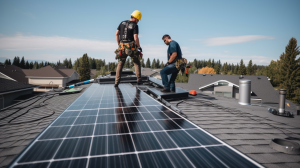 Hiring a professional solar installer brings a myriad of benefits that center on proficiency and ease. Such professionals are trained and certified to handle all the intricate details of solar panel installations. They use their in-depth knowledge about different types of solar systems and have an acute understanding of how these systems operate.
Hiring a professional solar installer brings a myriad of benefits that center on proficiency and ease. Such professionals are trained and certified to handle all the intricate details of solar panel installations. They use their in-depth knowledge about different types of solar systems and have an acute understanding of how these systems operate.
Further, their experience allows them to make the most effective use of available space, while ensuring that every single panel is strategically positioned to harness maximum sunlight. This kind of expertise brings inevitable efficiency to the installation process, making it less cumbersome, and most importantly, error-free.
Safety measures are another primary concern that professional solar installers rigorously adhere to. Solar panel installations involve climbing rooftops, drilling holes, dealing with electrical wiring which are high-risk tasks. Professionals are trained to mitigate these risks and they also come with insurance to cover for any unexpected accidents or damages. As they adhere to standard safety protocols, the homeowner is relieved from potential risks associated with the installation process. Therefore, hiring a professional solar installer provides a sense of security along with a proper and efficient set-up of the solar energy system.
In addition to these, there are several other aspects that you can expect from a professional solar installer. These include:
- Comprehensive Consultation: A professional solar installer will conduct an initial consultation to understand your energy requirements and assess the suitability of your property for a solar installation. They will provide expert advice on the best type of system for your needs and inform you about potential costs and savings.
- Customized Design: Based on their assessment, they will design a customized solution that fits perfectly with your home’s architecture while maximizing energy production. This includes determining the optimal placement of panels, angle orientation, and selecting suitable equipment.
- Quality Installation: Professional installers use top-grade materials and follow industry-standard practices during installation to ensure durability and longevity of the system. They also take care not to damage any part of your property during the process.
- System Testing & Commissioning: After installing the system, they perform necessary tests to ensure it’s working optimally. Once satisfied with its performance, they commission it into service so you can start benefiting from clean renewable energy immediately.
- After-Sales Support & Maintenance: Most professional installers offer after-sales support which includes regular maintenance checks and immediate assistance in case of breakdowns or malfunctions.
In conclusion, hiring a professional solar installer guarantees high-quality workmanship coupled with safety measures throughout all stages – from consultation through installation up until post-installation services.
Comparing Costs: DIY vs. Professional Services
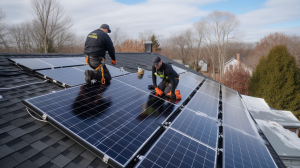 When it comes to the financial aspect of installing a solar energy system, the DIY approach may seem more cost-effective at first glance. The upfront cost of purchasing solar panels and other materials can indeed be lower than hiring a professional service. Moreover, by eliminating labor costs, a significant amount of money can potentially be saved.
When it comes to the financial aspect of installing a solar energy system, the DIY approach may seem more cost-effective at first glance. The upfront cost of purchasing solar panels and other materials can indeed be lower than hiring a professional service. Moreover, by eliminating labor costs, a significant amount of money can potentially be saved.
However, an in-depth cost comparison reveals that investing in professional services might prove to be more economical in the long run. The expertise and experience of professionals transfer into a more efficient and quicker installation process, which could translate into lower overall costs. Pro installers also provide warranties for their work, guaranteeing protection against future issues, thus potentially saving substantial amounts of money on maintenance and repairs in later years.
- DIY solar installation can lead to lower upfront costs due to the elimination of labor expenses. This includes:
◦ The cost of purchasing solar panels and other necessary materials is borne by the homeowner.
◦ There are no charges for professional installation services, which can be quite substantial.
However, when considering the long-term implications, hiring a professional service may prove more economical:
- Professional installers bring expertise and experience that result in an efficient and quick installation process. This could mean:
◦ Less time spent on installing means less disruption to your daily routine or business operations.
◦ Professionals have access to specialized tools and equipment that ensure proper installation. - Pro installers provide warranties for their work. These offer several potential benefits such as:
◦ Protection against future issues with the system – if anything goes wrong within the warranty period, it’s covered at no additional cost.
◦ Savings on maintenance and repair costs in later years – this can add up over time.
In conclusion, while DIY might seem like a cheaper option initially, factoring in efficiency, quality assurance through warranties provided by professionals may well outweigh these initial savings over time. Therefore it is essential for homeowners considering installing solar systems to take into account both immediate and long-term costs before making a decision.
Maintenance and Troubleshooting: DIY vs. Professional Care
Maintenance is one of the quintessential factors in ensuring the longevity and efficiency of solar energy systems. The type of maintenance required may vary depending on the age of the system, the quality of components used, and the peculiar environmental conditions where the installation was carried out. Engaging in a do-it-yourself maintenance routine would usually involve periodic cleaning of the solar panels, monitoring of system output, basic troubleshooting, and occasional part replacement. However, these tasks may require a considerable level of technical competence and dedication, as well as the risk of voiding the product warranty due to incorrect handling or intervention.
On the other hand, utilizing professional services for maintenance and troubleshooting has its unique appeals. Trained technicians have an in-depth understanding of complex system components, high levels of efficiency in task execution, and the ability to preempt potential issues through regular system audits. Furthermore, professional service providers often offer comprehensive warranties and maintenance plans to alleviate stress from homeowners, creating an opportunity for peace of mind and a more passive approach to the solar system ownership. Certainly, both methods have their merits, which should be carefully weighed considering the homeowners’ unique circumstances and preferences.
- DIY Maintenance:
○ The primary advantage of a do-it-yourself approach to solar system maintenance is the potential cost savings. By taking on tasks such as regular cleaning, monitoring and basic troubleshooting, homeowners can avoid the ongoing expenses associated with professional service contracts.
○ However, DIY maintenance requires a certain level of technical knowledge and dedication. Homeowners must be prepared to invest time in learning about their system’s components and operation, as well as staying up-to-date with best practices for care and upkeep.
○ There are also risks involved in handling solar systems without professional training. Incorrect procedures can cause damage or malfunctioning that may void the product warranty. - Professional Care:
○ Engaging professionals for solar system maintenance ensures high-quality workmanship backed by extensive industry knowledge. Trained technicians have an intricate understanding of complex components which allows them to effectively troubleshoot issues and perform repairs with minimal risk of error or damage.
○ Another key benefit is efficiency. Professionals carry out routine inspections swiftly yet thoroughly, identifying potential problems before they escalate into costly repairs or replacements.
○ Most professional service providers offer comprehensive warranties and maintenance plans designed to provide homeowners peace-of-mind. These packages often cover all aspects of care from regular check-ups to emergency repair services, allowing homeowners a more passive role in their solar system ownership.
In conclusion, both methods have unique advantages depending on individual circumstances including budget constraints, available time commitment for DIY projects versus preference for hassle-free solutions offered by professionals etc., hence should be considered carefully while deciding on the best approach towards maintaining your solar energy systems.
What are the basic components of a solar energy system?
The basic components include solar panels, an inverter, a battery storage system, and a solar charge controller. The solar panels convert sunlight into electricity, the inverter changes direct current to alternating current, the storage system stores excess power for later use, and the solar charge controller manages the power going into the battery bank.
How does one choose between installing solar panels themselves or hiring a professional?
Several factors come into play, including your level of knowledge and comfort with DIY projects, the complexity of your home’s roof layout, and the potential cost savings. It’s crucial to assess the pros and cons before making a decision.
What are the benefits and drawbacks of DIY solar installation?
DIY solar installation can save you money and provide a sense of accomplishment. However, it can be time-consuming, complex, and potentially dangerous if not done correctly. There’s also a risk of incorrect installation which could lead to inefficiency and damages.
What are the steps involved in installing solar panels?
The basic steps involve assessing your energy needs, choosing the right type of solar panel and inverter, installing the mounting hardware, attaching the solar panels, installing the inverter, and setting up the battery storage system.
What are the potential pitfalls of DIY solar systems?
Potential pitfalls include incorrect installation, causing system inefficiency and possible roof damage, lack of knowledge about local codes and regulations, and the absence of warranty protection on installation work.
What advantages do professional solar system setup provide?
Professionals bring expertise, experience, and knowledge of local codes and regulations. They can ensure correct and efficient installation, and their work typically comes with a warranty. They also handle all the paperwork related to permits and rebates.
What should one expect from a professional solar installer?
A professional solar installer will carry out a site survey, design a system tailored to your needs, handle all necessary permits and paperwork, install the system, and provide post-installation support and maintenance.
How do costs compare between DIY and professional solar installation?
While DIY might appear cheaper upfront, there are potential additional costs including tools, time spent, and the possible need for repairs due to incorrect installation. Professional installation can be more expensive upfront but includes warranties and typically ensures a well-installed, efficient system.
What is involved in the maintenance and troubleshooting of solar systems?
Maintenance involves regular cleaning of solar panels, inspecting and replacing damaged parts, and ensuring the system is operating efficiently. Troubleshooting can involve identifying and fixing issues like reduced power output, system failures, or battery problems.
How does DIY maintenance and troubleshooting compare to professional care?
DIY maintenance can save money, but requires knowledge on how to properly clean and maintain the system. Troubleshooting can be complex and potentially dangerous without proper knowledge. Professional care can provide peace of mind and ensures your system is optimally maintained and any issues are promptly resolved.

Nina Jerkovic
Meet Nina Jerkovic, our expert on all things green and sustainable. With a keen eye for eco-friendly living, Nina shares practical tips and insights to help you navigate the world of sustainable choices. Join her on a mission to create a healthier planet through mindful living.


